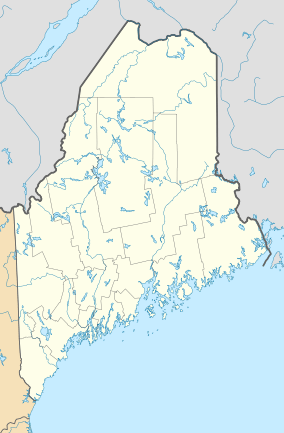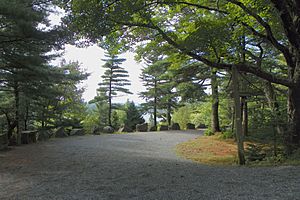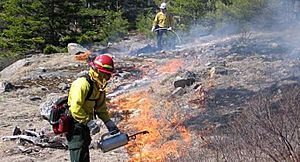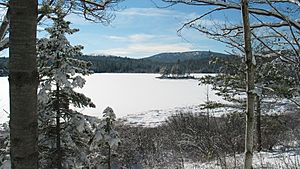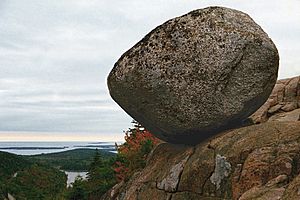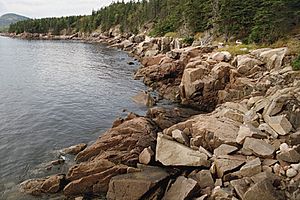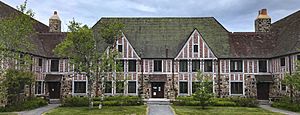Acadia National Park facts for kids
Quick facts for kids Acadia National Park |
|
|---|---|
|
IUCN Category V (Protected Landscape/Seascape)
|
|
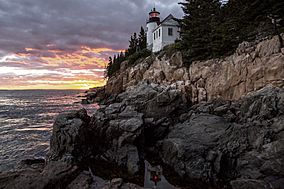
|
|
| Location | Hancock & Knox counties, Maine, United States |
| Nearest city | Bar Harbor |
| Area | 49,075 acres (198.60 km2) 861.46 acres (3.5 km2) private (in 2017) |
| Established | July 8, 1916 (as Sieur de Monts National Monument) February 26, 1919 (as Lafayette National Park) January 19, 1929 (as Acadia National Park) |
| Visitors | 2,669,034 (in 2020) |
| Governing body | National Park Service |
Acadia National Park is a beautiful national park located on the coast of Maine, in the northeastern United States. It protects a large part of Mount Desert Island, some smaller islands, and a piece of the Schoodic Peninsula. This special park keeps the natural beauty of rocky coastlines and tall mountains safe. It's known for its unique landscape shaped by glaciers, lots of different plants and animals, clean air and water, and a rich history.
Acadia is home to Cadillac Mountain, the tallest mountain along the Atlantic coast. You can see exposed granite rocks, huge boulders left by glaciers, and beaches made of smooth stones. The park's mountains, lakes, streams, forests, and coastlines create a home for many different kinds of plants and animals. There's also a historic system of carriage roads, built by John D. Rockefeller Jr., that are perfect for exploring. In total, the park covers about 49,075 acres.
People have lived in the Acadia area for over 10,000 years, starting with the Wabanaki people. In the 1600s, European explorers and fur traders arrived. Later, in the 1800s, wealthy families started visiting for summer vacations. Many people who cared about nature, like George B. Dorr, worked hard to create this park. It was the first U.S. national park east of the Mississippi River. It started as Sieur de Monts National Monument in 1916, then became Lafayette National Park in 1919, and finally Acadia National Park in 1929.
You can do many fun things in Acadia National Park! In spring, summer, and fall, you can drive or take a bus along the park's paved roads. You can also hike, bike, or ride horses on the special carriage roads where cars aren't allowed. Fishing, rock climbing, kayaking, and swimming are also popular. Park rangers lead programs to help you learn more about the park. In winter, you can go cross-country skiing, snowshoeing, snowmobiling, and ice fishing. There are campgrounds on Mount Desert Island and the Schoodic Peninsula, plus small campsites on Isle au Haut. The main visitor center is near Bar Harbor.
Contents
- Exploring Acadia's Landscape
- A Look Back in Time: Acadia's History
- Acadia's Weather and Seasons
- How Acadia Was Formed: Geology
- Plants and Animals of Acadia
- Fun Things to Do in Acadia
- Challenges Acadia Faces Today
- Visitor Centers
- Schoodic Education and Research Center
- Friends of Acadia
- See Also
- Images for kids
Exploring Acadia's Landscape
Acadia National Park has a mix of mountains, ocean coastlines, woodlands, lakes, and ponds. The park covers almost half of Mount Desert Island. It also includes part of the Schoodic Peninsula on the mainland and most of Isle au Haut. Other smaller islands like Baker Island and Bar Island are also part of the park. You can even walk to Bar Island across a sandbar at low tide!
John D. Rockefeller Jr. helped design and pay for about 57 miles of carriage roads on Mount Desert Island. About 45 miles of these roads are still used and maintained inside the park today. The park covers about 49,075 acres in total.
Amazing Mountains and Views
The mountains in Acadia National Park offer incredible views of the ocean, lakes, and pine forests. There are 26 important mountains in the park. They range from 284 feet tall at Flying Mountain to 1,530 feet tall at Cadillac Mountain. Cadillac Mountain is named after a French explorer. It's the tallest mountain along the eastern coast of the United States. From October 7 to March 6, you can be one of the first people in the U.S. to see the sunrise from the top of Cadillac Mountain!
The 27-mile Park Loop Road takes you to many beautiful spots along the coast. It goes through forests and up to the top of Cadillac Mountain. As you drive, you'll see places like Sand Beach, where you can swim in saltwater. You might also hear the loud crash of waves at Thunder Hole. Other famous spots include Jordan Pond, Eagle Lake, and the Bass Harbor Head Light lighthouse. This lighthouse sits on a cliff on the island's west side.
Somes Sound is a long, narrow inlet that almost cuts Mount Desert Island in half. It was formed by glaciers. It's about 130 feet deep at its deepest point. The towns of Southwest Harbor and Northeast Harbor are located across from each other at the entrance to Somes Sound.
A Look Back in Time: Acadia's History
The First People of Acadia
Native Americans have lived in the Acadia area for at least 12,000 years. These include the Wabanaki Confederacy ("People of the Dawnland"), made up of five related nations. They called Mount Desert Island Pemetic, meaning "range of mountains." This island has always been important to them. The name "Acadia" comes from a Mi'kmaq word akadie, meaning "piece of land."
The Wabanaki people traveled to the island in birch bark canoes. They hunted, fished, gathered berries, and collected materials for making baskets. They often camped near places like Somes Sound. In the early 1600s, European traders arrived, looking for furs. Sadly, wars and new diseases brought by Europeans greatly reduced the Native American population.
After the American Revolution, the border between the U.S. and Canada split the Wabanaki lands. Even though their confederacy ended, the tribes continued to connect in their traditional ways. In the 1800s, Wabanaki people sold handmade baskets to tourists. They also led canoe trips and performed dances for visitors. Today, Wabanaki people still live in Maine and visit Mount Desert Island for cultural events and to gather traditional materials.
Early Explorers and Settlers
European explorers began sailing along the coast of Mount Desert Island in the 1500s. Samuel de Champlain, a French explorer, arrived in 1604. He named the island "Isle des Monts Deserts" (Island of Barren Mountains) because of its rocky peaks.
The first French missionary colony in America was started on Mount Desert Island in 1613. However, it was soon destroyed by English forces. Later, in 1688, the island was given to Antoine de la Mothe Cadillac by the King of France. But it became English land in 1713.
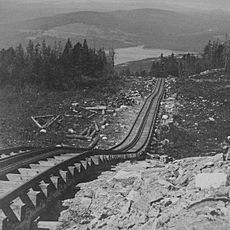
The first summer visitors came to the island in 1855. Steamboat service from Boston started in 1868, making it easier for people to visit. Artists and journalists helped make the island famous. Early visitors, called "rusticators," stayed in the homes of local fishermen. Soon, more hotels were built as tourism grew.
Wealthy "Cottagers" and Park Creation
In the late 1800s, very rich families like the Rockefellers, Morgans, and Fords began building large, fancy homes, which they called "cottages," on Mount Desert Island. These families enjoyed luxurious summer retreats. However, the Great Depression and World War II brought an end to this era of grand living.
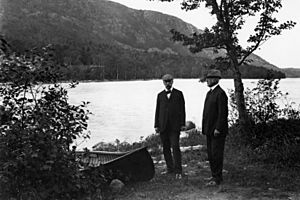
The idea for Acadia National Park came from landscape architect Charles Eliot. George B. Dorr, known as the "Father of Acadia National Park," worked with Eliot's father to make the park a reality. They donated land and pushed for its creation at the state and federal levels. President Woodrow Wilson first made it a national monument in 1916. It was special because it was the first national park created from private lands given to the public.
In 1919, the monument became Lafayette National Park. It was named after the Marquis de Lafayette, a French hero of the American Revolution. Later, in 1929, the park's name was changed to Acadia National Park. This honored the old French colony of Acadia that once included Maine.
From 1915 to 1940, the wealthy John D. Rockefeller Jr. paid for and helped design a network of carriage roads throughout the park. These roads were made of crushed stone and had 17 stone bridges. About 45 miles of these roads are still used today. The granite stones along the edges, which act as guard rails, are nicknamed "Rockefeller's Teeth." These roads are open for walking, biking, and horseback riding from late April through the winter, closing briefly in March for spring thaw.
The Great Fire of 1947
On October 17, 1947, a huge fire started in Acadia National Park. It burned over 10,000 acres within the park and another 7,000 acres outside it. This fire was part of many fires that happened in Maine that dry year. The fire lasted until November 14. Many people, including the Coast Guard, Army, Navy, local residents, and park staff, helped fight it. Sadly, 67 fancy summer homes and many other buildings were destroyed. The Rockefeller family helped a lot to restore the park after the fire. New trees like birch and aspen grew back, making the autumn colors even more beautiful.
Acadia's Weather and Seasons
Acadia has four distinct seasons. Summers are warm, sometimes hot and humid. Winters are cold, sometimes very cold. The average temperature in the park is about 47 degrees Fahrenheit (8.5 degrees Celsius). July is the warmest month, and January is the coldest.
The park gets a good amount of rain throughout the year. Snow usually falls from December to March, with January being the snowiest month. You might see snow from October to May!
How Acadia Was Formed: Geology

The rocks you see in Acadia National Park, especially the pinkish granite, are very old. They formed about 424 to 419 million years ago. Over millions of years, erosion wore down the land. Then, during the Pleistocene Ice Age, huge glaciers covered the area.
Glaciers Shaped the Land
About 2 to 3 million years ago, giant sheets of ice, called glaciers, moved across northern North America. These glaciers were incredibly powerful. The glacier that covered Mount Desert Island was about 1 mile thick! It slowly carved out the mountains, making them rounder. It also deepened valleys and created Somes Sound, which is a type of fjord.
You can still see signs of the last ice age, called the Wisconsin glaciation. Look for long scratches on the rocks, made by materials carried at the bottom of the ice. As the glaciers melted, they left behind huge boulders, called glacial erratics. These boulders were carried many miles from their original spots. One famous example is Bubble Rock, which sits on top of South Bubble mountain.
When the ice melted, the land slowly rose. Lakes and ponds formed in the valleys. Rivers and streams started flowing again, continuing to shape the landscape.
Coastal Erosion and Sea Caves
Acadia's coastline has rocky areas and beaches. The strong waves of the Atlantic Ocean constantly shape the coast. Where the waves hit hardest, you'll find only large boulders. In more protected areas, there are pebbles and smaller stones. Sheltered coves, like Sand Beach, have fine sand made mostly from crushed shells.
You can also find at least twelve sea caves along the park's coast. These caves are formed when waves slowly erode the rock. If a sea cave gets big enough, it might even break through a rocky point to form a sea arch.
Plants and Animals of Acadia

Acadia National Park has many different natural homes for animals and plants. Because it's on the coast, it attracts a wide variety of species. However, since the park is not huge and is somewhat isolated, you'll see more smaller animals than very large ones like black bears or moose.
Diverse Plant Life
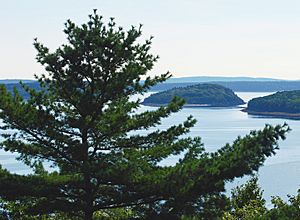
Acadia has both deciduous forests (trees that lose their leaves) and coniferous forests (evergreen trees like pines and firs). You'll find plants like lowbush blueberries, Canadian bunchberries, and white pine trees in both types of woodlands.
Coniferous forests are home to trees like balsam fir, eastern hemlock, and red spruce. Over 60% of the park's natural areas are covered by spruce-fir forests. Deciduous forests have trees like white ash, aspen, American beech, and different kinds of maples.
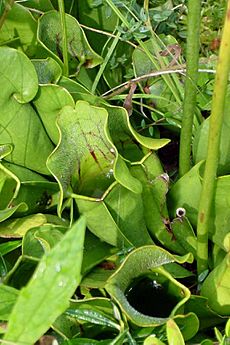
In the mountains and rocky areas, you might see gray birch and common juniper. Bogs, which are wet, spongy areas, have unique plants like the pitcher plant, which is a carnivorous plant! Meadows and roadsides are filled with wildflowers like fireweed and common milkweed.
The Mount Desert Island part of the park has more than half of all the different plant species found in Maine. There's even a special garden called The Wild Gardens of Acadia that shows over 400 native plant species from the park.
Amazing Animals of Acadia
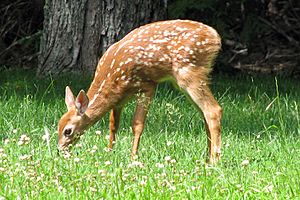
The park is home to 37 different kinds of mammals. These include:
- Carnivores: black bears, coyotes, red foxes, raccoons, North American river otters, and American mink.
- Hoofed Animals: moose and white-tailed deer.
- Rodents: beavers, groundhogs, porcupines, and many types of mice and squirrels.
- Other Mammals: Shrews, moles, and the snowshoe hare.
- Bats: Several species of bats live here, but a fungal disease called white-nose syndrome has affected them.
You can also find seven types of reptiles, including five kinds of snakes and two kinds of turtles. Eleven different amphibians live in the park, such as American toads, various frogs, and salamanders.
The most common fish in the park's waters are American eels, golden shiners, and pumpkinseeds. You might also see brook trout.
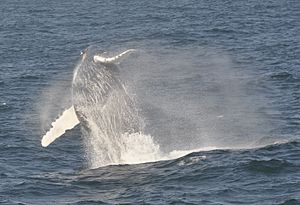
In the ocean waters around Acadia, you can spot many marine animals. These include seals and whales. You can take a boat tour or go sea kayaking to see them. Special whale-watching trips leave from Bar Harbor.
Over 200 different bird species visit Acadia throughout the year, including many migratory birds. You might see large birds like golden and bald eagles, ospreys, and various herons and owls. Many types of ducks and geese are also present.
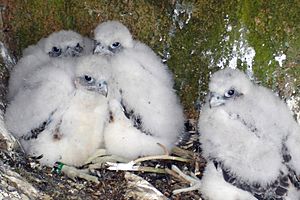
One special bird is the red crossbill. This finch has a unique beak that helps it get seeds out of pinecones. In 1991, peregrine falcons successfully nested in Acadia again after many years. Since then, over 160 chicks have been born in the park! Sometimes, certain trails are closed to protect these nesting falcons.
Fun Things to Do in Acadia
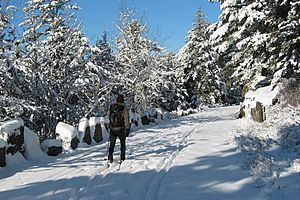
The 27-mile Park Loop Road is great for driving and sightseeing. It usually opens in mid-April and closes on December 1, depending on snow. A small part of the road is open all year.
You can explore the coastline on guided boat trips or by sea kayak. Canoeing and kayaking are also popular on the park's lakes and ponds. There are about 125 miles of hiking trails through forests and mountains. The 45 miles of carriage roads are perfect for hiking or bicycling (no motorized vehicles allowed). You can also go horseback riding on the carriage roads.
If you like climbing, Otter Cliff and Great Head are popular spots. For swimming, Sand Beach has saltwater, and Echo Lake Beach has freshwater. In summer, ocean water is usually 50-60 degrees Fahrenheit, while lake water is 55-70 degrees.
Park rangers offer fun programs from mid-May to mid-October. These include short walks, longer hikes, boat cruises, evening talks, and special programs for kids. You can also learn about peregrine falcons and other birds of prey.
In winter, you can go snowshoeing or use special traction footwear on trails. Cross-country skiing is popular on the carriage roads. You can also go snowmobiling on the paved loop road and ice fishing on frozen ponds.

Acadia has several campgrounds. Blackwoods Campground and Seawall Campground are on Mount Desert Island. Schoodic Woods is a newer campground on the Schoodic Peninsula. There are also small campsites on Isle au Haut. Blackwoods Campground is open all year, but others are open from late spring to early autumn.
The park also hosts the annual Acadia Night Sky Festival. This event brings together speakers, photographers, and artists to celebrate the park's dark night skies.
Challenges Acadia Faces Today
Too Many Visitors
Acadia National Park has become very popular, with over 3.5 million visitors in 2018. Most visitors come in the summer, which can cause traffic jams and make it hard to find parking. This puts a lot of stress on the park's roads and staff.
To help with this, the Island Explorer bus system offers free rides. It has carried millions of passengers since 1999, helping to reduce car traffic.
Changes in the Environment
Since Acadia National Park was founded in 1916, the climate has changed. The growing season for plants is now almost two months longer. This can be a problem because it allows invasive species (plants that aren't native and can harm the ecosystem) to grow more easily. A longer warm season also means more tourists, which adds more pressure on the park's resources. Changes in rainfall also affect the park, requiring more maintenance to prevent erosion on trails and roads.
Needed Repairs
Park officials estimated that Acadia needed about $65.8 million in repairs and maintenance in 2019. This is part of a much larger problem across all U.S. national parks. When repairs are delayed, it can make existing problems worse. This includes fixing roads, trails, and other park buildings.
Visitor Centers
There are six visitor information centers in or near Acadia National Park. The main one is at Hulls Cove, near Bar Harbor. There's also a nature center at Sieur de Monts and an information center on Thompson Island. Other centers are in Bar Harbor, Islesford (on Little Cranberry Island), and the Schoodic Peninsula. The Rockefeller Welcome Center on the Schoodic Peninsula is the only one open all year.
Schoodic Education and Research Center
After a naval base on the Schoodic Peninsula closed in 2002, the land became part of the park. It's now the Schoodic Education and Research Center (SERC). This center works with a nonprofit group to support scientific research in the park. It also helps teachers learn more about nature and teaches students to care for the park.
Friends of Acadia
In 1986, a group called Friends of Acadia (FOA) was formed. This group helps the park by organizing volunteers and raising money. One of their biggest achievements was raising $3.4 million to help maintain the park's carriage roads forever. They also helped create the Island Explorer, the free bus system that serves the park and local towns.
FOA also started the Acadia Youth Conservation Corps. This program hires high school students to help maintain trails and carriage roads in the summer. They also have the Acadia Digital Media Team, which teaches teens how to use professional tools to appreciate and protect nature.
See Also
 In Spanish: Parque nacional Acadia para niños
In Spanish: Parque nacional Acadia para niños
Images for kids



